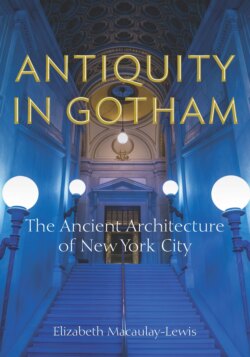Читать книгу Antiquity in Gotham - Elizabeth Macaulay-Lewis - Страница 8
Why Antiquity?
ОглавлениеSince the United States’ inception, classical antiquity and, to a lesser extent, ancient Egypt and the ancient Near East have been powerful models for American art and architecture because of the flexibility, diversity, and potency of meaning that these forms carried. As the scholars Shane Butler and Brooke Holmes note, classical antiquity is not monolithic2 but fluid, flexible, endlessly mutable,3 and untimely.4 Classical antiquity changes with place and time, and thus the legacy of antiquity is complex and rich. The classical world held a special place for the United States. Not only were Greece and Rome seen as the originators of “Western Civilization,” but the political, philosophical, and intellectual traditions of the classical world, specifically the concepts of tyranny and good governance, were core to the Founding Fathers’ arguments supporting the Revolutionary War, while the ideas of republicanism and democracy informed the development of the government of the newly formed United States.5 The architecture of ancient Athens and Republican Rome could symbolize the ideals of democracy; unsurprisingly, classical forms were used for some of the earliest public buildings in Washington, DC, including the original Capitol building and Palladian-style White House, both of which burned down in 1814. Thomas Jefferson’s home Monticello, his Rotunda at the University of Virginia, and his designs for the Virginia State Capitol emulated Roman models, specifically the Pantheon and the Maison Carrée. The Roman Empire, once avoided as a model because of its decline and fall, was embraced as the United States was politically and economically on the rise in the late nineteenth century. With its imperial power and majesty, Rome became a model for emulation—with certain American caveats. The exceptional American empire, built on trade and merit and composed of citizens (not subjects),6 would prevail, unlike the Roman and European empires, where a king or emperor reigned. However, the imperial overtones of Rome would not resonate easily with American democracy in the early twentieth century, so the relationship between ancient Roman forms and American architecture would once again be renegotiated.
Likewise, the Latin language was seen to have a degree of permanence and universality that later civilizations and languages lack, allowing it to transcend religious, ethnic, and social differences.7 The monumental pyramids, obelisks, and sphinxes of Egypt were also considered by later architects and artists to reflect technological achievements and to have an enduring timelessness.8 The architecture of ancient Egypt’s thousands of years of history undoubtedly brought a sense of permanence to a nation that was less than a century old. Likewise, the ancient Near East also offered highly original and exotic—although not often replicated—forms. The events of the Bible also played out across Egypt and the ancient Near East, forging another tie.
Ancient architecture could offer a new nation suitable political references, bring gravitas to newly founded cultural institutions and universities, dignity to a civic edifice, or a touch of luxury to a restaurant. Immigrants, veterans, and others who did not belong to the city’s elite also used ancient forms to create architecture that could convey their aspirations and identity. In New York City, different places and points in antiquity and its rich architectural history provide useful, diverse models to architects, patrons, tastemakers, and politicians to express their status (or their company’s strength), document key moments of New York City’s history and the city’s goals, as well as to create much-needed infrastructure. Together Greece, Rome, Egypt, and the ancient Near East provided the new nation and city with a series of useable pasts ripe for repeated reinvention.
